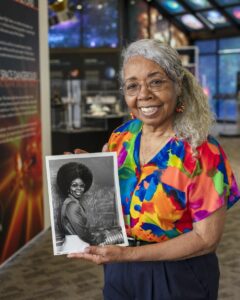54 Valerie Thomas
Dr. Valerie Thomas |
 |
Time period:1960s – present Subject:Physics and Mathematics |
|
Biography:Dr. Valerie Thomas is an American scientist and inventor who was born during 1943 in Maryland. From a very early age, she was quite fascinated with technology, eventually leading her to pursue physics and mathematics. Growing up in a racially segregated society, as well as being a woman, she was not presented with as many opportunities for education as white students. However, she prevailed and was very academically successful in high school, and moved onto post secondary. She graduated from Morgan State College in 1964 with a bachelors degree in physics. Dr. Thomas then began working at NASA as a data analyst, and continued through various roles before retiring in 1995. In 1985, she earned a masters degree in engineering administration from George Washington University, as well as a doctorate in educational leadership from the University of Delaware in 2004. She has been a strong proponent of girls and women, as well as African Americans, to pursue education and careers in STEM, supporting organizations such as Women in Science and Engineering and Shades of Blue, which focuses on aviation and aerospace.
|
|
Summary of their contributions:During her time at NASA, Dr. Thomas assisted in developing the image-processing system for NASA’s Landsat. This program involves satellites which gather data on Earth’s natural resources. Dr. Thomas specifically worked as the leader of the Large Area Crop Inventory Experiment, which sought to collect data on wheat yields around the world using Landsat images. In 1976, after being inspired by a demonstration where a lightbulb seemed to remain lit after being removed from a lamp, she became fascinated with 3D illusions. She then began experimenting, subsequently inventing the illusion transmitter, which uses a video recorder to take a picture of a floating image in front of a concave mirror. The video is sent to a second camera which projects the image onto a second concave mirror, therefore creating the illusion of a 3D image. Dr. Thomas received a patent for the illusion transmitter in 1980, and NASA used this technology for some of their satellite applications. In 1986, she became the project manager of the Space Physics Analysis Network of NASA. This program aimed to help scientists collaborate and share information on space-related topics. Before her retirement in 1995, she was the associate chief of the Space Science Data Operations Office.
|
|
Integration with the BC Secondary Science Curriculum:Dr. Thomas’ work can be applied to many areas of the BC Science Curricula. Specifically, her work and story could be used as an example in the Science 10 Earth Science Curricula. The Landsat could be discussed as an example of astronomical data and collection methods, which is one of the content learning standards for Science 10. Her story could also be discussed for the curricular competency of “connecting scientific explorations to careers in science”. Her work with the illusion transmitter could also be used in the Physics 11 Curricula. It applies to the content learning standard of properties and behaviours of waves, as this involves reflection and refraction. These properties are used with the concave mirrors of the illusion transmitter.
|
|
References:Data, M. N. (2019). Meet dr. Valerie L. Thomas, Landsat Image Processing Specialist. NASA. https://mynasadata.larc.nasa.gov/stem-career-connections/meet-dr-valerie-l-thomas-landsat-image-processing-specialist Encyclopædia Britannica, inc. (2023). Valerie Thomas. Encyclopædia Britannica. https://www.britannica.com/biography/Valerie-Thomas Valerie Thomas. Lemelson. (n.d.). https://lemelson.mit.edu/resources/valerie-thomas |
|

